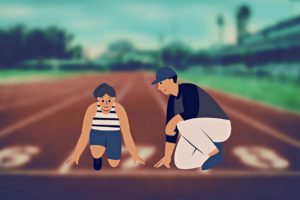Are you struggling to help your child navigate their emotions? Do you find that they have a hard time expressing themselves or understanding how they feel? Teaching emotional literacy to children is crucial for their overall development and well-being.
By modeling healthy emotional expression and discussing emotions with your child, you can help them better understand and manage their feelings. Research shows that children who are emotionally literate have better social skills, academic performance, and are less likely to engage in risky behaviors.
As a parent, you play a critical role in helping your child develop emotional intelligence. By being aware of your own emotions and modeling healthy ways to express them, you can set a positive example for your child to follow.
In this article, we will explore the importance of emotional literacy for children and provide practical tips for teaching emotional intelligence through modeling and discussing parent emotions.
Key Takeaways
- Parents play a critical role in modeling healthy emotional expression and discussing emotions with children
- Validating and acknowledging children’s emotions teaches them how to recognize and regulate their own feelings
- Creating a safe space where your child feels comfortable expressing their feelings is important for discussing emotions with children
- Helping your child identify their triggers and using age-appropriate language can make discussing emotions a fun and positive experience
Understanding the Importance of Emotional Literacy for Children
You’ve gotta understand how crucial it is for your little ones to have emotional literacy skills in order to navigate through life’s ups and downs.
Emotional literacy refers to the ability to recognize, understand, and manage one’s own emotions, as well as to empathize with others. The benefits of emotional literacy for children are numerous, including better decision-making skills, improved relationships with others, and an increased ability to handle stress and adversity.
It also helps children to regulate their emotions and express themselves in healthy ways, which in turn promotes mental well-being.
As a caregiver, you play a crucial role in fostering emotional intelligence in your children. By modeling healthy emotional expression and discussing your own emotions with your children, you can help them develop their own emotional literacy skills.
By validating and acknowledging their emotions, you can teach them how to recognize and regulate their own feelings. It’s important to remember that emotional intelligence is a skill that can be developed and cultivated, and that it requires ongoing effort and practice.
By prioritizing emotional literacy in your parenting, you can help your children develop the tools they need to thrive in all areas of their lives.
Modeling Healthy Emotional Expression
Feeling your emotions and expressing them in a healthy way is important for teaching your kids how to do the same. Children learn by watching the adults around them, and modeling healthy emotional expression can go a long way in helping them develop their own emotional literacy. This means being aware of your own emotions and practicing empathy and active listening when your child expresses their emotions.
To help you model healthy emotional expression, here’s a table that outlines some examples of what to do and what to avoid when it comes to expressing emotions:
| Do | Don’t | Why |
|---|---|---|
| Take deep breaths before responding | React immediately without thinking | Taking deep breaths helps you calm down and respond in a more thoughtful way. |
| Use "I"statements to express how you feel | Blame or criticize the other person | Using "I"statements helps you express how you feel without making the other person feel attacked. |
| Listen actively to what the other person is saying | Interrupt or ignore the other person | Active listening shows the other person that you care about what they have to say and can help resolve conflicts. |
| Take responsibility for your actions | Make excuses or blame others | Taking responsibility shows that you understand the impact of your actions and are willing to make amends. |
| Apologize when necessary | Refuse to apologize or dismiss the other person’s feelings | Apologizing shows that you value the other person’s feelings and are willing to make things right. |
By practicing empathy and active listening, and using the "Do"column of the table as a guide, you can model healthy emotional expression for your kids and help them develop their own emotional literacy.
Discussing Emotions with Children
Let’s explore ways to have fun and engaging conversations with your little ones about their emotions. It’s important to create a safe space where your child feels comfortable expressing their feelings.
Here are three ways to make discussing emotions with your child a fun and positive experience:
Identify Triggers: Help your child identify their triggers, or the events or situations that cause them to feel a certain way. This can help them understand their emotions better and develop coping mechanisms. Ask questions like, "What made you feel sad today?"or "What made you happy?"
Age-Appropriate Language: Use language that is appropriate for your child’s age and developmental stage. For younger children, use simple words and phrases to help them understand their emotions. For older children, use more complex language and encourage them to reflect on their emotions.
Active Listening: Show your child that you’re actively listening to them when they share their emotions. This means giving them your full attention, making eye contact, and responding in a supportive and non-judgmental way. Encourage them to express themselves and validate their feelings.
By incorporating these tips into your conversations with your child, you can help them develop emotional literacy and build healthy relationships with their feelings. Remember to be patient and understanding as your child learns to navigate their emotions.
Using Everyday Opportunities to Teach Emotional Literacy
Incorporating everyday moments into daily routines can help children understand and express their feelings more effectively. For example, when you witness your child having a tantrum or getting upset, try to identify the trigger that caused the outburst. By discussing the trigger with your child, you can help them understand why they feel the way they do and give them the tools to manage their emotions in the future.
Another way to teach emotional literacy is by using empathy. When your child is upset, try to put yourself in their shoes and imagine how they must be feeling. By acknowledging their emotions and showing them that you understand, you can help them feel validated and supported. This can also help them develop empathy for others, which is an important emotional skill that will benefit them throughout their lives. In the table below, we’ve provided some examples of how to use empathy in everyday situations to help your child develop emotional literacy.
| Situation | Empathetic Response | Result |
|---|---|---|
| Your child is upset about not being able to have a toy | "I can see that you really wanted that toy. It’s hard when we can’t have something we want." | Your child feels heard and understood, and may be more willing to move on from the situation. |
| Your child is feeling anxious about starting a new school year | "It’s normal to feel nervous about new experiences. I remember feeling the same way when I started a new school." | Your child feels validated and less alone in their feelings, which can help them feel more confident going forward. |
| Your child is angry about not being able to play with a friend | "I understand that you’re upset about not being able to play with your friend. It’s disappointing when plans don’t work out." | Your child feels understood and may be more willing to talk about how they’re feeling and find a solution. |
Encouraging Emotional Intelligence in Children
If you want to encourage emotional intelligence in your children, you need to focus on four key areas:
- Developing self-awareness
- Self-regulation
- Social awareness
- Relationship skills
Helping your child to understand and identify their own emotions is the first step in developing self-awareness. Self-regulation involves teaching your child how to manage their emotions in a healthy and constructive way.
Social awareness is all about empathy and understanding the emotions of others, while developing relationship skills involves teaching your child how to communicate effectively and build positive relationships.
Developing Self-Awareness
Developing self-awareness is crucial for children to understand and regulate their own emotions. One way to help them develop self-awareness is by encouraging a journaling practice where they can reflect on their thoughts and feelings. This allows children to identify their emotions and understand why they feel a certain way.
As a parent, you can also guide them through mindfulness exercises where they learn to focus on the present moment and observe their thoughts and feelings without judgment. By developing self-awareness, children become more in tune with themselves and can better communicate their emotions to others.
They learn to recognize their triggers and develop coping mechanisms to deal with them. This skill also helps them build empathy towards others as they understand that everyone experiences different emotions.
As a parent, it’s important to model self-awareness by reflecting on your own emotions and discussing them with your child. This creates a safe space for them to express themselves and learn from your experiences.
Developing Self-Regulation
Now that you’ve developed self-awareness, it’s time to move on to the next step: developing self-regulation.
Self-regulation is all about being able to control your emotions and actions in difficult situations. It’s a crucial skill to have, especially for children who are still learning how to navigate the world around them.
One of the best ways to teach self-regulation is by practicing breathing techniques and mindfulness exercises. These techniques can help children calm down and relax when they’re feeling overwhelmed or upset.
By teaching your child how to take deep breaths and focus on the present moment, you’re giving them the tools they need to handle difficult situations with grace and ease. With practice, these techniques can become second nature, allowing your child to regulate their emotions and behavior more effectively.
Developing Social Awareness
You can improve your ability to understand and connect with others by practicing social awareness. Teaching empathy is a crucial part of developing social awareness in children. When children learn to recognize emotions in others, they can begin to understand and relate to their peers on a deeper level. This can lead to better communication, stronger relationships, and a more positive social environment.
To develop social awareness in children, try these four strategies:
Model empathy: Children learn by example, so it’s important to show them how to empathize with others. When you encounter someone who’s upset or struggling, take a moment to acknowledge their feelings and offer support.
Encourage perspective-taking: Help your child see things from another person’s point of view. Ask questions like, "How do you think they’re feeling?"or "What do you think they’re thinking?"
Practice active listening: When someone’s speaking, give them your full attention. Show that you’re listening by making eye contact, nodding, and responding appropriately.
Use books and media to spark conversations: Reading books or watching movies with your child can be a great way to start talking about emotions and social situations. Ask questions about the characters’ feelings and encourage your child to share their own thoughts and emotions.
Developing Relationship Skills
Improving your ability to connect with others and build strong relationships is essential for a fulfilling life, and honing your relationship skills is one way to do so.
Role playing scenarios and active listening exercises are effective ways to develop these skills. Through role playing, you can practice communication and problem-solving in a safe and controlled environment.
Active listening exercises can help you understand others’ perspectives and develop empathy. Role playing scenarios can be as simple as practicing a conversation with a friend or family member, or as complex as simulating a conflict resolution with a coworker. It allows you to explore different communication styles and learn how to navigate difficult conversations.
Active listening exercises, on the other hand, involve focusing your attention on what the other person is saying and reflecting back what you heard. By doing so, you can better understand their thoughts and feelings, and build a stronger connection. These exercises can be done with a partner or in a group setting, and can be particularly helpful for those who struggle with social anxiety or shyness.
Frequently Asked Questions
How does emotional literacy affect a child’s academic performance?
Emotional literacy has a significant impact on a child’s academic performance. When children have developed emotional regulation techniques, they’re better able to manage their emotions and focus on tasks at hand.
This leads to improved academic performance and a higher level of engagement in the classroom. Additionally, emotional literacy has a positive impact on social skills.
Children who’re emotionally literate are better able to communicate their feelings, empathize with others, and form positive relationships. Overall, emotional literacy plays a critical role in a child’s success both academically and socially.
Can emotional literacy be taught to children with special needs?
Yes, emotional literacy can be taught to children with special needs. Social interaction and sensory integration play a critical role in the emotional development of children with special needs. By providing them with opportunities to engage in social interactions and sensory experiences, they can learn to identify and regulate their emotions.
It’s important to create a safe and supportive environment that encourages the expression of emotions and provides opportunities for children to practice emotional regulation strategies. Additionally, using visual aids such as social stories and emotion charts can be helpful in teaching emotional literacy to children with special needs.
With patience and consistent support, children with special needs can develop emotional literacy skills that will benefit them in all aspects of their lives.
What are some common mistakes parents make when discussing emotions with their children?
When discussing emotions with your children, it’s important to avoid invalidation. This means not dismissing or minimizing your child’s feelings, even if they seem trivial or insignificant to you.
Encouraging open communication is also key, as it allows your child to express their emotions freely and feel heard. Some common mistakes parents make when discussing emotions with their children include ignoring or belittling their child’s feelings, jumping to solutions or advice without first listening, and shutting down or avoiding conversations about difficult emotions.
By creating a safe and open environment for emotional expression, you can help your child develop emotional literacy and a healthy relationship with their feelings.
How can parents model healthy emotional expression when they are dealing with their own emotional struggles?
When dealing with your own emotional struggles, it’s important to practice self-care practices to help regulate your emotions before expressing them to your child. This can include taking a few deep breaths, going for a walk, or talking to a friend.
Once you have done this, you can then model healthy emotional expression by role playing scenarios with your child. For example, you can act out a situation where you are feeling angry and show them how you can express your feelings in a calm and respectful manner.
By doing this, you’re not only teaching your child how to handle their own emotions, but also showing them that it’s okay to feel and express them in a healthy way.
Are there any negative consequences to encouraging emotional intelligence in children?
Encouraging emotional intelligence in children may have some potential negative consequences that parents should be aware of.
For example, emotional literacy can impact a child’s relationships with peers and adults. Teaching children to express their emotions and empathize with others may make them more sensitive to social cues and better able to navigate social situations. However, it could also make them more vulnerable to negative feedback and criticism.
Additionally, research suggests that emotional intelligence can have long-term effects on adult success and happiness. While emotional intelligence has been linked to better mental health and job performance, it may also lead to higher levels of stress and burnout in high-pressure positions.
Ultimately, parents should strive to find a balance between teaching emotional literacy and allowing their children to develop their own emotional intelligence in a way that works for them.
Conclusion
Congratulations on taking the first step to teach emotional literacy to your child! By understanding the importance of emotional literacy, modeling healthy emotional expression, and discussing emotions with your child, you’re setting them up for success in their emotional intelligence.
Remember to use everyday opportunities to teach emotional literacy and encourage your child to express their emotions in healthy ways.
By teaching your child emotional literacy, you’re giving them the tools to navigate their emotions and relationships in a healthy and positive way. As they grow and develop, they’ll be able to communicate their feelings effectively, empathize with others, and form strong and meaningful connections.
Keep up the great work and continue to prioritize your child’s emotional well-being.

















